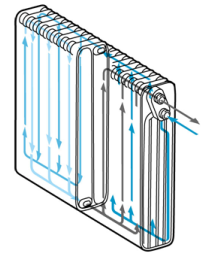The evaporator performs the opposite function to a condenser within the A/C system. The evaporator absorbs the heat from the outside, warm air, while the condenser dissipates this heat to the outside air. To cool down the (outside) warm air before it moves into the car’s cabin, the air is ‘pushed’ through the cold evaporator fins. Inside the evaporator flows low-pressure, low-temperature liquid refrigerant (mist), which changes state to gaseous refrigerant by absorbing this heat from the warm outside air.
The vaporized refrigerant is then sucked into the compressor, compressed further and transported to the condenser, where it changes state to liquid by dissipating heat to the outside air. The liquid refrigerant then travels to the expansion valve and back to the evaporator. This process is called the refrigerant cycle.



